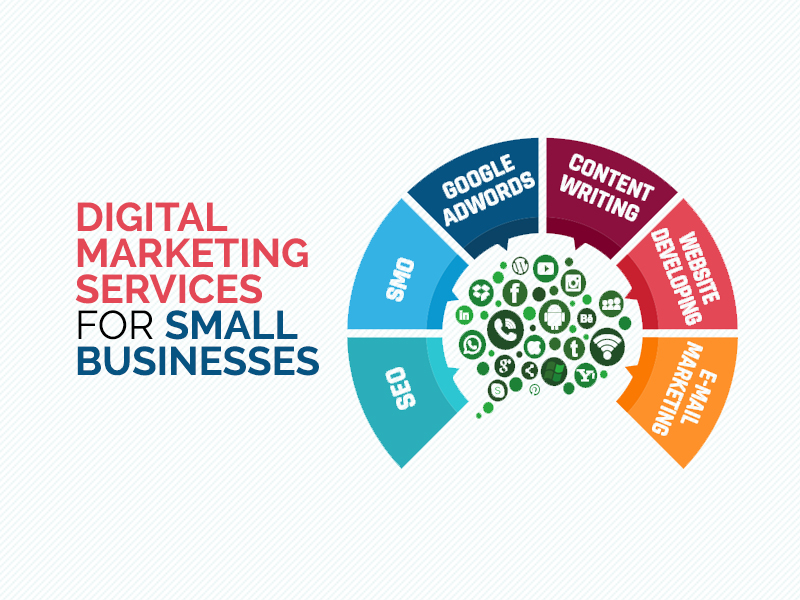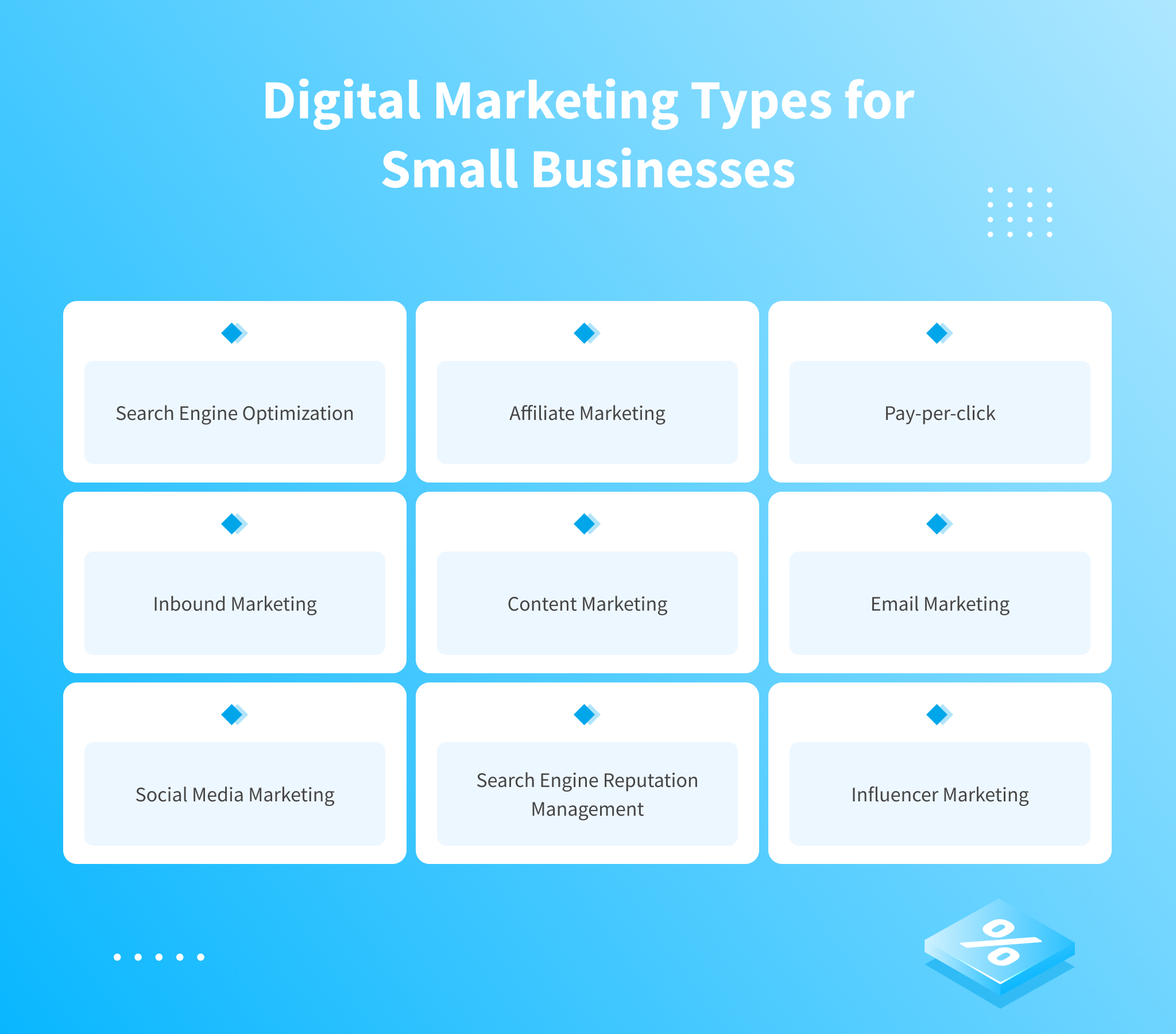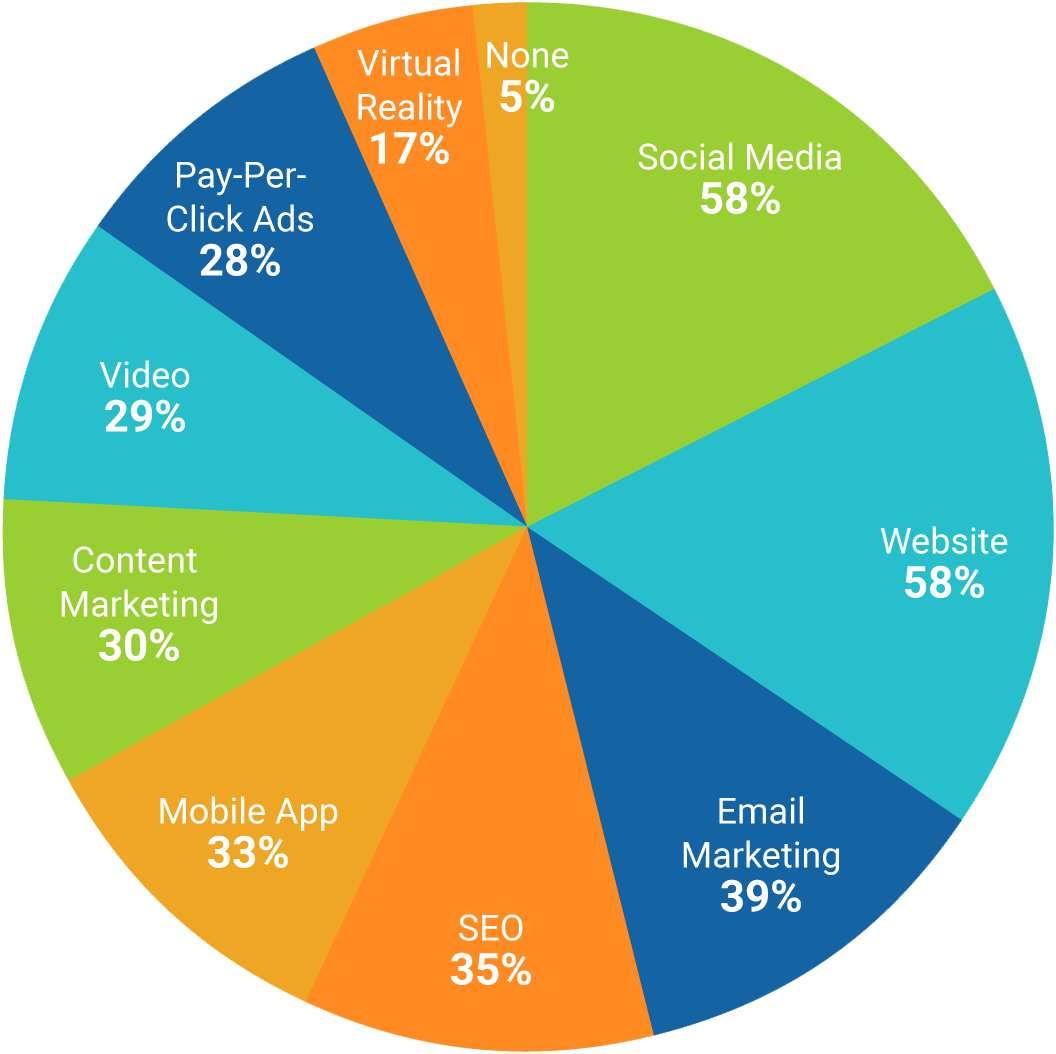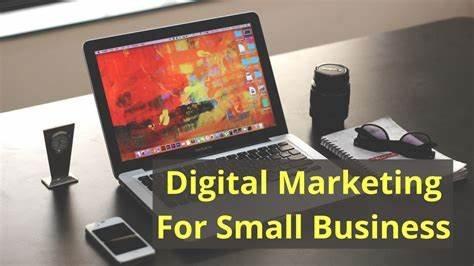Digital marketing helps small businesses increase online visibility and reach a broader audience. It offers cost-effective strategies to compete with larger companies.
Digital marketing has revolutionized how small businesses operate and grow. It leverages online platforms to boost brand awareness and drive customer engagement. Small businesses can use targeted advertising, social media marketing, and search engine optimization to attract potential customers. These strategies help build a robust online presence, leading to increased sales and revenue.
Digital marketing also provides valuable insights through analytics, allowing businesses to refine their approaches and improve results. By adopting digital marketing, small businesses can stay competitive, reach more customers, and achieve sustainable growth. This shift is essential for any small business aiming to thrive in today’s digital age.

Credit: evergreen-marketingsolutions.com
Boosting Online Presence
Digital marketing is a game-changer for small businesses. Boosting your online presence can attract more customers, increase sales, and grow your brand. Let’s explore how digital marketing helps small businesses by focusing on two key strategies: creating a website and utilizing social media.
Creating A Website
A website is your digital storefront. It allows customers to learn about your products and services 24/7. Having a professional website boosts your credibility and trustworthiness.
Key benefits of a website for small businesses include:
- Visibility: Your website makes your business visible to a global audience.
- Accessibility: Customers can access information about your business anytime.
- Cost-effective marketing: A website serves as an affordable marketing tool.
- Customer engagement: Engage with customers through blogs, FAQs, and contact forms.
Important elements to include on your website:
| Element | Description |
|---|---|
| Homepage | First impression of your business, must be engaging. |
| About Us | Share your business story and values. |
| Product/Service Pages | Detail your offerings with high-quality images and descriptions. |
| Contact Information | Make it easy for customers to reach you. |
| Customer Reviews | Showcase testimonials to build trust. |
Utilizing Social Media
Social media platforms are powerful tools for small businesses. They help connect with customers and build a loyal community.
Advantages of social media for small businesses:
- Brand awareness: Increase your visibility and reach a larger audience.
- Customer engagement: Interact with customers through comments, messages, and posts.
- Cost-effective advertising: Run targeted ads without a huge budget.
- Real-time feedback: Receive immediate feedback from customers.
- Content sharing: Share valuable content to educate and entertain your audience.
Popular social media platforms to consider:
- Facebook: Ideal for community building and advertising.
- Instagram: Great for visual content and engaging younger audiences.
- Twitter: Useful for real-time updates and customer service.
- LinkedIn: Perfect for B2B connections and professional networking.
- Pinterest: Excellent for sharing visual content and driving traffic.
Tips for effective social media usage:
- Consistency: Post regularly to keep your audience engaged.
- Quality content: Share high-quality images, videos, and articles.
- Engagement: Respond to comments and messages promptly.
- Analytics: Use analytics tools to measure your performance.
Targeting The Right Audience
Small businesses often struggle with reaching their ideal customers. Digital marketing helps small businesses by targeting the right audience. This ensures marketing efforts are not wasted and reach those who are most likely to buy their products or services. Here’s how digital marketing helps in targeting the right audience.
Defining Buyer Personas
Creating buyer personas is the first step in targeting the right audience. A buyer persona is a detailed description of your ideal customer. It includes demographics, behavior patterns, motivations, and goals. This helps small businesses understand who their customers are and what they need.
To define a buyer persona, consider the following details:
- Demographics: Age, gender, income level, education, and occupation.
- Behavior Patterns: Online behavior, shopping habits, and preferred social media platforms.
- Motivations: What drives your customers to make a purchase?
- Goals: What are your customers trying to achieve?
Here’s an example of a buyer persona:
| Attribute | Details |
|---|---|
| Name | Jane Doe |
| Age | 35 |
| Occupation | Marketing Manager |
| Goals | Improve marketing strategies |
| Challenges | Lack of time and resources |
By defining buyer personas, small businesses can tailor their marketing messages to resonate with their target audience. This increases the chances of engaging potential customers and converting them into loyal buyers.
Using Analytics Tools
Analytics tools are essential for targeting the right audience. They provide valuable insights into customer behavior and preferences. Google Analytics, Facebook Insights, and HubSpot are popular tools used by small businesses.
Google Analytics helps track website traffic. It shows where visitors come from, what they do on your site, and how long they stay. This data helps small businesses understand which marketing channels are most effective.
Facebook Insights offers data on how users interact with your Facebook page. It shows which posts get the most engagement, the demographics of your followers, and the best times to post. This helps in creating content that resonates with your audience.
HubSpot provides detailed reports on email marketing, social media, and lead generation. It helps track the performance of different marketing campaigns. This ensures small businesses can optimize their strategies for better results.
Here’s a table comparing these tools:
| Tool | Features |
|---|---|
| Google Analytics | Website traffic analysis, user behavior, conversion tracking |
| Facebook Insights | Post engagement, follower demographics, optimal posting times |
| HubSpot | Email marketing, social media reports, lead generation tracking |
Using these tools, small businesses can make data-driven decisions. This ensures their marketing efforts are effective and reach the right audience. Digital marketing becomes more efficient and yields better results.
Cost-effective Strategies
Digital marketing offers various cost-effective strategies that help small businesses grow without breaking the bank. Traditional marketing methods often come with high costs and limited reach. In contrast, digital marketing provides affordable options that ensure a broader audience. These methods include email marketing and content marketing. These strategies are not only budget-friendly but also highly effective in driving engagement and sales.
Email Marketing
Email marketing is a cost-effective way to connect with customers. It allows small businesses to send personalized messages directly to their audience. This method is inexpensive, yet it offers a high return on investment (ROI). Here are some reasons why email marketing is beneficial:
- Low Cost: Sending emails is cheaper than printing flyers or buying ad space.
- High ROI: According to studies, every dollar spent on email marketing generates $42 in return.
- Targeted Audience: Businesses can segment their email lists to target specific groups.
- Measurable Results: Tools like open rates and click-through rates help track performance.
Here is a simple table showing the benefits of email marketing:
| Benefit | Description |
|---|---|
| Low Cost | Minimal expenses for sending emails |
| High ROI | Significant returns on investment |
| Targeted Audience | Reach specific customer segments |
| Measurable Results | Track and analyze campaign performance |
Content Marketing
Content marketing involves creating valuable content to attract and engage an audience. This strategy is cost-effective and helps build brand awareness. By providing useful information, businesses can establish themselves as industry experts. Here are some key points about content marketing:
- Affordable: Creating and sharing content costs less than traditional ads.
- Builds Trust: High-quality content helps build trust with your audience.
- Improves SEO: Search engines favor websites with valuable content, improving rankings.
- Engages Customers: Engaging content keeps customers coming back for more.
Here are some types of content marketing:
- Blog Posts: Regular articles that provide value and insights.
- Videos: Engaging visuals that explain products or services.
- Infographics: Visual representations of data and information.
- E-books: In-depth guides on specific topics.
Small businesses can use these strategies to reach a broader audience without spending a fortune. By focusing on email marketing and content marketing, they can achieve significant growth and success.

Credit: nix-united.com
Enhancing Customer Engagement
Small businesses thrive on strong customer relationships. Digital marketing helps in enhancing customer engagement. Engaged customers are more loyal and likely to recommend the business. This section explores how digital marketing can foster engagement through building community and responding to feedback.
Building Community
Creating a sense of community is vital for small businesses. Digital marketing offers tools to connect with customers. Social media platforms are perfect for this.
- Facebook Groups: Build exclusive groups for loyal customers.
- Instagram Stories: Share behind-the-scenes content.
- Twitter Chats: Host weekly chats on relevant topics.
These platforms help businesses share updates, promotions, and news. They also allow for real-time interaction with customers. Engaging content encourages customers to interact with the brand.
| Platform | Engagement Features |
|---|---|
| Groups, Live Videos, Comments | |
| Stories, Reels, Direct Messages | |
| Chats, Polls, Hashtags |
Email marketing is another tool to build community. Regular newsletters keep customers informed. Personalized emails make customers feel valued. These efforts result in a loyal and engaged customer base.
Responding To Feedback
Feedback is crucial for small businesses. Digital marketing makes gathering and responding to feedback easy. Customers often leave reviews on social media and websites.
- Monitor Reviews: Keep an eye on reviews on Google and Yelp.
- Respond Quickly: Answer queries and comments promptly.
- Address Complaints: Resolve issues to show you care.
Responding to feedback shows customers their opinions matter. It helps build trust and improve the business. Social media listening tools can track mentions of your brand. This ensures you never miss any feedback.
Negative feedback should be seen as an opportunity. Addressing complaints publicly shows transparency. Positive feedback can be shared to boost your brand’s image. This two-way communication helps in building stronger relationships.
Surveys and polls are other ways to gather feedback. Use tools like SurveyMonkey or Google Forms. Make it easy for customers to share their thoughts. This data helps in improving products and services.
Leveraging Seo
Digital marketing is a game-changer for small businesses. Leveraging SEO (Search Engine Optimization) can be a powerful tool. It helps businesses improve their online visibility, attract more customers, and grow. SEO involves optimizing your website to rank higher in search engine results. This drives more traffic to your site. Let’s dive into how small businesses can leverage SEO effectively.
Keyword Research
Keyword research is the first step in any SEO strategy. It involves identifying the words and phrases potential customers use to search for your products or services. Proper keyword research can help you target the right audience and improve your site’s ranking.
- Identify Primary Keywords: Find the main terms your audience uses. Use tools like Google Keyword Planner or SEMrush.
- Analyze Competitors: Look at the keywords your competitors rank for. This can give you insights and help you find gaps.
- Long-Tail Keywords: These are longer phrases with lower search volume but higher conversion rates. They are often less competitive.
- Search Intent: Understand what users intend to find. Keywords should match the user’s intent, whether it’s informational, navigational, or transactional.
Here’s a simple table to help you understand keyword types:
| Keyword Type | Description | Example |
|---|---|---|
| Short-Tail Keywords | 1-2 words, high search volume | “Shoes” |
| Long-Tail Keywords | 3+ words, lower search volume | “Best running shoes for men” |
| Local Keywords | Location-based, high intent | “Coffee shop in Austin” |
On-page Optimization
On-page optimization refers to the elements on your website that you can control. This includes content, HTML tags, and images. Optimizing these elements helps search engines understand your site better and rank it higher.
- Title Tags: Each page needs a unique title tag. It should include your primary keyword and be under 60 characters.
- Meta Descriptions: These are short descriptions that appear below the title in search results. Include your primary keyword and keep it under 160 characters.
- Header Tags: Use H1 tags for titles and H2-H6 tags for subheadings. This helps organize your content.
- Content Quality: Write high-quality, relevant content. Include primary and secondary keywords naturally.
- Image Alt Text: Describe your images using keywords. This helps with accessibility and SEO.
Here’s a brief checklist for on-page SEO:
| Element | Optimization Tips |
|---|---|
| Title Tags | Include primary keyword, under 60 characters |
| Meta Descriptions | Include primary keyword, under 160 characters |
| Header Tags | Use H1 for titles, H2-H6 for subheadings |
| Content | High-quality, relevant, keyword-rich |
| Image Alt Text | Describe images using keywords |
Utilizing Paid Advertising
Digital marketing is a game-changer for small businesses. Utilizing paid advertising helps these businesses reach new customers quickly. This method is efficient and provides measurable results. Let’s explore how Google Ads and Social Media Ads can help small businesses thrive.
Google Ads
Google Ads is a powerful tool for small businesses. It allows them to appear in search results for specific keywords. This means they can target people actively looking for their products or services. Here are some benefits:
- Immediate Visibility: Your ads appear on the first page of search results.
- Cost Control: You set your budget and only pay when someone clicks your ad.
- Targeted Audience: You can target by location, age, and even interests.
Google Ads offers various ad formats, such as:
| Ad Type | Description |
|---|---|
| Search Ads | Text-based ads that appear in search results. |
| Display Ads | Image-based ads shown on websites within the Google Display Network. |
| Video Ads | Ads that appear on YouTube and other video platforms. |
Using Google Ads can significantly boost your online presence. It drives traffic to your site and converts visitors into customers. Setting up a campaign is straightforward and offers comprehensive analytics to monitor performance.
Social Media Ads
Social Media Ads are essential for reaching a broader audience. Platforms like Facebook, Instagram, and Twitter offer robust advertising options. These ads can engage users based on their interests and behaviors. Key benefits include:
- Wide Reach: Social media platforms have billions of active users.
- Engagement: Interactive ad formats like polls and stories capture user interest.
- Cost-Effective: You can start with a small budget and scale up as needed.
Different platforms offer unique ad formats:
| Platform | Ad Format |
|---|---|
| Carousel Ads, Video Ads, Sponsored Posts | |
| Story Ads, Photo Ads, Shopping Ads | |
| Promoted Tweets, Follower Ads, Trend Takeovers |
Social media ads provide detailed targeting options. You can reach people based on their demographics, interests, and online behavior. This makes social media advertising incredibly effective for small businesses aiming to build brand awareness and drive sales.
Measuring Success
Digital marketing is crucial for small businesses. It helps them reach more customers and grow. One key part of digital marketing is measuring success. Knowing what works and what doesn’t is vital. This helps small businesses to improve and achieve their goals.
Tracking Metrics
Tracking metrics is essential for measuring success. Metrics provide data that shows how well your digital marketing efforts are working. Some important metrics to track include:
- Website Traffic: The number of visitors to your website.
- Conversion Rate: The percentage of visitors who take a desired action, like making a purchase.
- Click-Through Rate (CTR): The ratio of users who click on a specific link to the number of total users who view it.
- Social Media Engagement: Likes, shares, and comments on your social media posts.
- Email Open Rate: The percentage of recipients who open your email.
To make this easier, use tools like Google Analytics, which can track various metrics. Here’s a simple table to summarize key metrics:
| Metric | What It Measures |
|---|---|
| Website Traffic | Number of visitors to your site |
| Conversion Rate | Percentage of visitors who convert |
| CTR | Users who click a link vs. those who view it |
| Social Media Engagement | Interactions on social media posts |
| Email Open Rate | Recipients who open your email |
Regularly tracking these metrics helps you see what’s working and what needs improvement. With this data, you can make better decisions for your business.
Adjusting Strategies
Once you have tracked your metrics, it’s time to adjust your strategies. This ensures your digital marketing efforts are effective. Here are some steps to adjust your strategies:
- Analyze the Data: Look at your metrics to see patterns and trends. Identify areas where performance is low.
- Set Goals: Based on the data, set clear, achievable goals. For example, increase website traffic by 20% in three months.
- Test Different Approaches: Try different marketing tactics. For example, change your social media posting times or email subject lines.
- Monitor Changes: Keep tracking your metrics to see how changes affect performance. Adjust further if needed.
Here’s a simple example:
Example: If your social media engagement is low, you might:
- Post more frequently
- Use different types of content, like videos or infographics
- Engage with your audience by replying to comments
Regularly adjusting your strategies ensures your marketing efforts stay effective. This helps your small business grow and succeed.

Credit: www.eminentseo.com
Building Brand Loyalty
Small businesses thrive on loyal customers. Digital marketing helps build brand loyalty, which keeps customers coming back. Loyal customers spend more and recommend your business to others. Building brand loyalty is easier with digital marketing tools and strategies.
Creating Loyalty Programs
Creating loyalty programs is a powerful way to build brand loyalty. These programs reward customers for their repeat business. Digital marketing makes it easy to manage and promote loyalty programs.
Why Loyalty Programs Work:
- Incentives: Customers love earning rewards for their purchases.
- Engagement: Loyalty programs keep customers engaged with your brand.
- Data Collection: Track customer behavior to improve marketing strategies.
Types of Loyalty Programs:
| Program Type | Description |
|---|---|
| Points System | Customers earn points for purchases. They redeem points for rewards. |
| Tier System | Customers achieve higher status with more purchases. Higher tiers get better rewards. |
| Referral Programs | Customers earn rewards for referring friends. |
Digital marketing tools like email campaigns and social media help promote these programs. Use personalized emails to inform customers about their rewards. Share success stories and testimonials on social media to attract new members.
Encouraging Reviews
Encouraging reviews builds trust and loyalty. Positive reviews act as social proof, showing potential customers that your business is reliable. Digital marketing helps you collect and showcase reviews effectively.
How to Encourage Reviews:
- Ask for Feedback: Send follow-up emails asking customers to leave reviews.
- Make it Easy: Provide direct links to review sites in your emails and on your website.
- Incentivize Reviews: Offer small discounts or freebies for leaving a review.
Showcasing Reviews:
- Website: Display customer reviews prominently on your site.
- Social Media: Share positive reviews on your social media channels.
- Email Campaigns: Include testimonials in your marketing emails.
Use digital tools to monitor and respond to reviews. Thank customers for positive feedback and address any negative reviews professionally. This shows that you value customer opinions and are committed to improving your service.
Frequently Asked Questions
What Is Digital Marketing?
Digital marketing uses online platforms to promote products or services. It includes SEO, social media, email, and content marketing. This helps businesses reach a larger audience.
How Can Digital Marketing Help Small Businesses?
Digital marketing enhances visibility and reach. It allows targeted advertising and direct engagement with customers. This leads to increased brand awareness and sales.
Why Is Seo Important For Small Businesses?
SEO improves website visibility on search engines. Higher rankings attract more organic traffic. This leads to more potential customers and higher conversion rates.
What Are The Benefits Of Social Media Marketing?
Social media marketing increases brand awareness and customer engagement. It allows direct communication with customers. This boosts loyalty and drives sales.
Conclusion
Digital marketing drives growth and visibility for small businesses. It offers cost-effective strategies and measurable results. By leveraging digital marketing, small businesses can compete with larger enterprises. Embrace digital tools to reach your target audience effectively. Start your digital marketing journey today and watch your small business thrive. If you have any query about digital marketing please contact Web Invento



